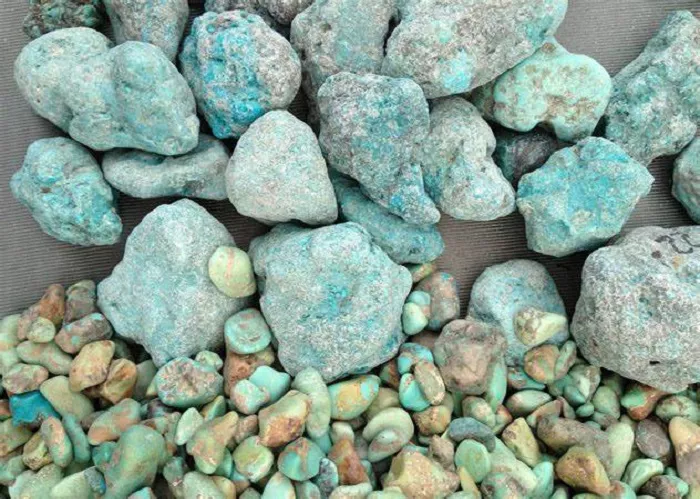Turquoise is a stunning gemstone loved for its vibrant blue and green hues. Many people wonder about its durability. Does real turquoise break easily? The answer depends on several factors, including the stone’s hardness, porosity, and how it is treated.
In this article, we will explore the durability of real turquoise. We will discuss its hardness, common causes of damage, and how to care for it properly. By the end, you will know whether turquoise is fragile and how to keep it in good condition.
What Is Turquoise?
Turquoise is a phosphate mineral. It forms in dry, copper-rich regions. The stone gets its blue color from copper and its green shades from iron. High-quality turquoise is prized for jewelry, carvings, and decorative items.
The most famous turquoise sources include:
- Iran (Persian turquoise)
- The Southwestern United States (Arizona, Nevada, New Mexico)
- China
- Egypt
- Mexico
How Hard Is Turquoise?
Gemstones are measured on the Mohs hardness scale. This scale ranges from 1 (softest) to 10 (hardest). Turquoise ranks between 5 and 6 on this scale.
For comparison:
- Diamond (10) – Extremely hard, nearly unbreakable.
- Quartz (7) – Harder than turquoise, used in many jewelry pieces.
- Glass (5.5) – Similar to turquoise, can scratch easily.
- Gold (2.5-3) – Much softer than turquoise.
Since turquoise is only moderately hard, it can scratch or chip if hit against hard surfaces. However, it is not as fragile as some softer gems like opal or pearl.
Why Does Turquoise Sometimes Break?
Even though turquoise is not the most fragile gemstone, it can still break under certain conditions. Here are the main reasons why turquoise may crack or chip:
Natural Porosity
Turquoise is a porous stone. This means it has tiny holes and cracks inside. Some turquoise is more porous than others. High-quality turquoise is denser and less likely to break. Lower-quality turquoise is more brittle.
Stabilized vs. Natural Turquoise
Natural turquoise is untreated. It is more fragile because of its porosity.
Stabilized turquoise has been treated with resin or wax. This makes it harder and more durable.
Stabilized turquoise is less likely to break. Most commercial turquoise jewelry uses stabilized stones.
Impact Damage
Turquoise can crack if dropped or hit against a hard surface. Rings and bracelets are more prone to damage because they bump into things often. Pendants and earrings are safer choices.
Temperature Changes
Sudden temperature changes can cause turquoise to crack. For example:
Washing hands with hot water while wearing a turquoise ring.
Leaving a turquoise necklace in a cold car, then bringing it into a warm room.
Exposure to Chemicals
Turquoise is sensitive to chemicals, including:
- Perfume
- Hairspray
- Cleaning products
- Chlorine (in pools)
- Acids (lemon juice, vinegar)
These substances can weaken the stone and make it more likely to break.
How to Prevent Turquoise from Breaking
If you love turquoise jewelry, you can take steps to protect it. Here are the best ways to keep your turquoise from cracking or chipping:
Choose Stabilized Turquoise for Jewelry
Stabilized turquoise is stronger. It is a better choice for rings and bracelets that face daily wear.
Avoid Wearing Turquoise Rings During Rough Activities
Take off your turquoise ring when:
- Doing housework
- Gardening
- Exercising
- Working with tools
Store Turquoise Properly
Keep it in a soft pouch or lined jewelry box.
Avoid storing it with harder gems (like diamonds) that could scratch it.
Clean Turquoise Gently
Use a soft, damp cloth to wipe it.
Avoid ultrasonic cleaners and steam cleaning.
Never soak turquoise in water for long periods.
Avoid Extreme Temperatures
Don’t leave turquoise in direct sunlight for too long.
Remove jewelry before swimming (hot tubs, pools, or the ocean).
Reapply Protective Coatings (If Needed)
Some turquoise is coated with wax or oil to protect it. Over time, this coating wears off. A jeweler can reapply it to keep the stone strong.
Can Broken Turquoise Be Repaired?
If your turquoise cracks or chips, you have a few options:
Gluing Small Cracks
A jeweler can use special adhesive to fix minor cracks. However, this is only a temporary solution.
Re-cutting the Stone
If a large piece breaks off, a lapidary (gem cutter) can reshape the stone into a smaller cabochon or bead.
Replacing the Stone
Sometimes, the best option is to replace the damaged turquoise with a new stone.
How to Tell If Turquoise Is Real or Fake
Since fake turquoise (plastic, dyed howlite, or resin) is common, it’s important to know if your stone is genuine.
Signs of Real Turquoise:
- Uneven color (natural variations)
- Visible matrix (dark veins or spiderweb patterns)
- Cool to the touch (plastic feels warm)
- Slightly porous texture
Signs of Fake Turquoise:
- Too perfect (unnaturally even color)
- No matrix (completely smooth)
- Lightweight (plastic is lighter than real stone)
- Bubbles inside (sign of resin or glass)
Conclusion
Real turquoise is not the most fragile gemstone, but it can break under certain conditions. Its moderate hardness (5-6 on the Mohs scale) and porosity make it more delicate than diamonds or sapphires. However, with proper care, turquoise jewelry can last for generations.
To keep your turquoise safe:
- Choose stabilized turquoise for durability.
- Avoid impacts, chemicals, and extreme temperatures.
- Store and clean it gently.
If you take these precautions, your turquoise jewelry will stay beautiful for years. While it may not be as tough as a diamond, its unique color and cultural significance make it a treasure worth protecting.
Related topics:
Who Should Wear Turquoise Ring?
Do You Activate A Turquoise Ring?


